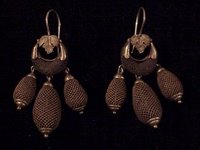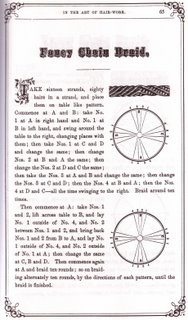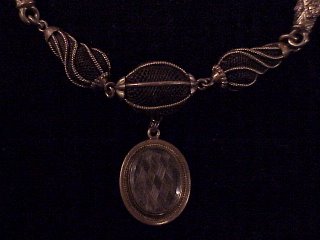Hairwork Jewelry: Table Worked Hair
 The revival of hairwork jewelry in the 1980-90s has revealed that the equipment and basic patterns for table work hair braiding are identical to kumihimo braiding in Japan. Kumihimo braiding was used to construct durable silk cords for clothing and samurai armor from at least 700 AD to the present. However, this method of working hair was probably independently invented in Europe and shares no lineage with Japanese kumihimo. It nevertheless uses the same technique of weighted hair strands joined by a counter weight and passed back and forth across different quadrants of the tabletop.
The revival of hairwork jewelry in the 1980-90s has revealed that the equipment and basic patterns for table work hair braiding are identical to kumihimo braiding in Japan. Kumihimo braiding was used to construct durable silk cords for clothing and samurai armor from at least 700 AD to the present. However, this method of working hair was probably independently invented in Europe and shares no lineage with Japanese kumihimo. It nevertheless uses the same technique of weighted hair strands joined by a counter weight and passed back and forth across different quadrants of the tabletop. Frontispiece from Mark Campbell's (1875) The Art of Hairwork: Hair Braiding and Jewelry of Sentiment illustrating the table stand used to create hairwork braids.

A table work pattern from The Art of Hairwork

Lacis has republished Mark Campbell's books and Alexanna Speight's (1872) The Lock of Hair, which are available through their website. Lacis also has a store in Berkley filled with an amazing selection of books and supplies for the whole spectrum of art and craft textiles and adornment. The staff is freindly, helpful, and willing to share their passion and enthusiasm for all things related to antiques and dress. Check out their website: Lacis
This brooch and earrings set was constructed with the table work method using a pattern for a hollow open work braid.

This watch chain was constructed from two different patterns for solid chains, which were then braided together. The hairwork beads encased in gold wire were crafted using a hollow open work pattern.

The hairwork beads suspend a double-sided locket with two different palette worked hair designs on each side.

This engraving of the same watch chain pictured above comes from the catalog pages of Mark Campbell’s 1875 how-to book for the amateur hairworker.




0 Comments:
Post a Comment
<< Home